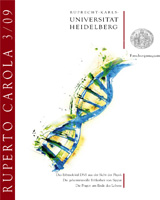Ruperto Carola 3/09: The Mysterious World of Sippar
Heidelberg research magazine with articles on cuneiform research, physics and medicine – Interdisciplinary research on “human dignity at the end of life”
 In its 3/09 edition, Heidelberg University’s research magazine “Ruperto Carola” reports on “Texts from a Lost World”. In Heidelberg, Markus Hilgert is engaged in research on the mysterious Sippar Library. While there is controversy about whether it was a “temple library”, there is no doubt that it represents a unique collection of cuneiform manuscripts. At present, the first-ever edition of this fascinating cache of Babylonian scholarship is taking shape in Heidelberg. Only when all the manuscripts have been translated will it be possible to gauge the true significance of this treasure-trove from a long-lost world.
In its 3/09 edition, Heidelberg University’s research magazine “Ruperto Carola” reports on “Texts from a Lost World”. In Heidelberg, Markus Hilgert is engaged in research on the mysterious Sippar Library. While there is controversy about whether it was a “temple library”, there is no doubt that it represents a unique collection of cuneiform manuscripts. At present, the first-ever edition of this fascinating cache of Babylonian scholarship is taking shape in Heidelberg. Only when all the manuscripts have been translated will it be possible to gauge the true significance of this treasure-trove from a long-lost world.
Modern physics is grappling with a question that is as fundamental as it is hard to answer. How does life originate from inanimate matter? If we look at the basic constituent of all life, the hereditary molecule deoxyribonucleic acid (DNA), it appears at first glance to be nothing other than a collection of components joined in a long chain that fulfils a biological function in that specific arrangement. But on closer inspection it appears that this ordered structure can change into a disordered one at astonishing speed – and without forfeiting functionality. Understanding the frequently astounding principles of life is a challenge that Heidelberg physicists have been squaring up to with the assistance of biologists and mathematicians. Dieter W. Heermann gives an account of their research work.
Michael Anderheiden’s article discusses “New Issues at the End of Life”. Though dying is just as much a part of life as any other of its phases, scientific engagement with the phenomenon is still in its infancy. The Heidelberg research group “Human Dignity at the End of Life” has set out to change this situation. Under the aegis of the Marsilius Kolleg, scientists and scholars from various fields of endeavour have joined forces to investigate the topic in all its scientific and societal implications. Their aim is to produce a manual on “humane dying” designed not only to provide a comprehensive theoretical basis for discussion but also to guide an unsure public through this dramatically changing landscape.
New contrast media facilitate the precise diagnosis of multiple sclerosis. Martin Bendzsus’ article on the subject is entitled “A Better Picture”. For some fifteen years there has been medication available that can slow the progress of multiple sclerosis. The earlier this severe inflammatory disease of the central nervous system is detected, the better the prospects of success. An important diagnostic tool is magnetic resonance tomography, a modern imaging method that visualises the potentially devastating changes taking place in the central nervous system. New contrast media now promise to help detect the changes characteristic of multiple sclerosis earlier and with greater certainty. The “better picture” is the precondition for quicker treatment.
Treating pancreatic tumours is a difficult task, always demanding new strategies. Over the last few years, a major study – called the CapRi Study – has been testing the efficacy of a new combined post-operative therapeutic method. The results are so encouraging that the study has now gone into a second stage. The ongoing CapRi II Study is investigating the degree to which individual therapy components affect treatment outcomes. The ultimate objective is to optimise treatment of these tumours and to significantly improve patients’ prospects for recovery. The combined therapy for tumours of the pancreas is explained by Thilo Hackert and Markus Büchler.
Under the title “A Letter from the Emperor”, a brief report by Jörg Peltzer discusses rank and social standing in the late Middle Ages. In that period (1200-1500) the hierarchically organised societies of pre-modern Europe went through an enormously dynamic phase that particularly affected the higher nobility. New princely elites took shape and had a sustained effect on political and social systems. Although these processes have been recognised as such, they have yet to be thoroughly investigated. The research group “Rang und Ordnung/RANK” takes a comparative and interdisciplinary approach to the formation and visualisation of princely rank in late-medieval Europe.
What is the role played by personification in the image and writing culture of the early modern age? One of four young research groups participating in Heidelberg University’s Transcultural Studies Programme, newly established in the framework of the Excellence Initiative, has been investigating this issue since 2008. The “personification principle” stands revealed as a central figure of thought in the early modern age. Its consistencies and disparities are the subject of study in five sub-projects whose purview extends from the late Middle Ages to the modern age and from Europe to South America. In a brief report entitled “Neues Leben für alte Bilder. Personifikationen im Wandel der Zeiten und Kulturen” (New Life for Old Images: Personification through Changing Times and Cultures), Cornelia Logemann outlines the research work being done on this topic.
Please address any inquiries to
Heidelberg University
Communications and Marketing
Dr. Michael Schwarz
Editor-in-chief “Ruperto Carola”
michael.schwarz@rektorat.uni-heidelberg.de
Irene Thewalt
phone: +49 6221 542311
fax: +49 6221 542317
presse@rektorat.uni-heidelberg.de

